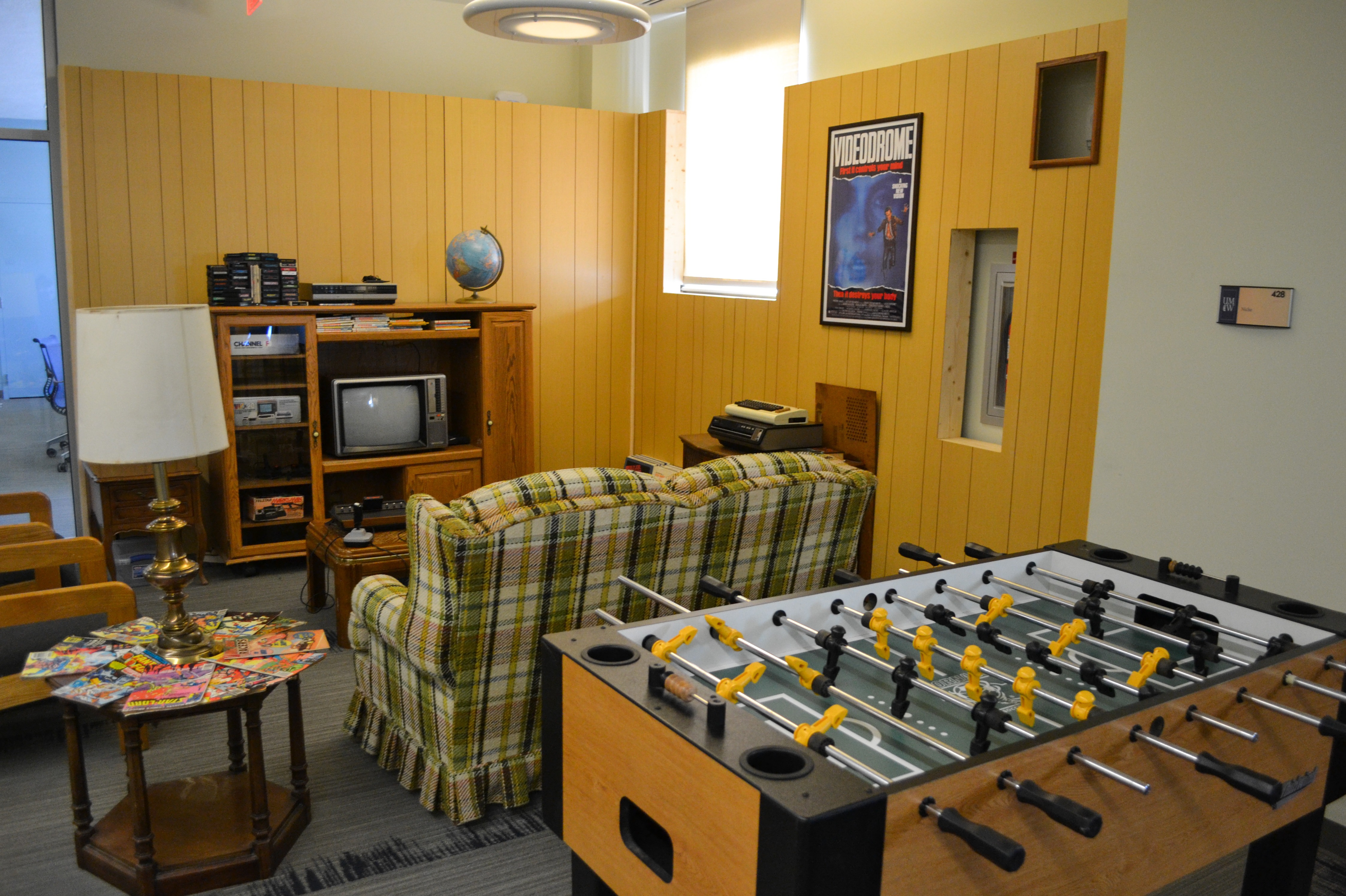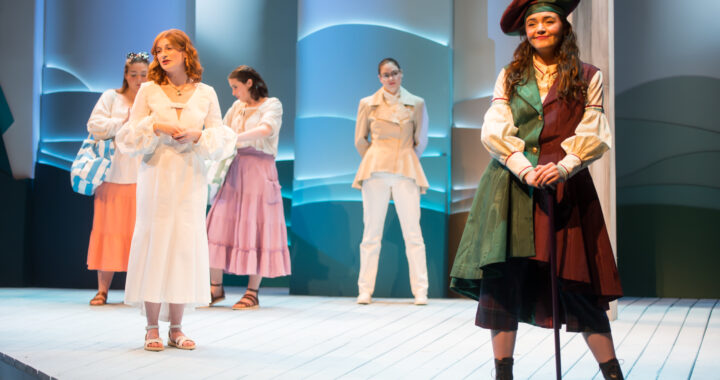A retro vibe finds a corner in the modern Convergence Center
5 min read
Ginny Clark | The Blue & Gray Press
By ALISON THOET
With smartphones in hand and computers on laps, it can be hard for this generation not to look down upon old technology. Yet we still sit on living room couches with friends, invested in video games, television and music, no different than most kids did in generations past.
This is the idea of the “80s Console Living Room” that looks like it was picked up from 1985 and tucked in a corner on the fourth floor of the Information and Technology Convergence Center.
“Technology has historically converged at home in the living room,” said Zach Whalen, associate professor of English, linguistics and communication. “It is a showcase to represent this idea.”
The fourth floor exhibit is a showcase indeed. Enclosed in wooden paneling, the “family couch” is quite “Mad Men”-esque in its yellow-green plaid tweed. The brown wooden console holds an old television, VCR player and games, all across from the coffee table which houses the different, and rather aged game consoles. An old record player, foosball table, comics and other relics give the room an additional relic vibe.
Whalen and Executive Director of Teaching & Learning Technologies Jim Groom spearheaded this blast from the past project.
What began as conversation on collecting old games and technology quickly turned into the formation of a physical 30-year anniversary of “Back to the Future” as a backdrop for displaying the media convergence of a different era within the wider arena of the UMW ITCC. In fact, a poster for the film hangs as its own backdrop on the wooden paneling, highlighting the back to the future of media convergence theme.
The 80s era was also highlighted because it was the first time media came into the home in a way that people could watch movies and play games from their living room couch.
“It’s a really interesting world. This was a start for a whole generation of engineers, computer people, and also just aesthetic and design,” said Groom.
They tried to include owner manuals and other marketing materials for the media to help give a conceptual idea of how new this technology was at the moment.
“The idea is that this captures a moment in time,” said Groom. “It’s a time capsule of the changing media landscape in the 80s.”
As it turns out, the exhibit was also perfectly timed and themed for a visit from the 1985 UMW alumni class visit this May.
But for now the room is a surprise for passersby and a hidden jewel for some students at UMW. Whalen, who directs the minor in digital studies at UMW, uses the room for class field trips for his Games and Culture course. He hopes the room teaches students about media archaeology, or studying old media in the context of the new.
“From my end there’s the pedagogical aspect,” said Whalen. “I wanted to talk about technology as an ecosystem of converging technology.”
The room gives students a hands-on experience where our media today emerges from, rather than just reading about it because “you miss the experience – the moments of being there on the couch playing it, the little quirks,” according to Whalen.
“I hope they have fun with it,” said Whalen. “Part of the point is this stuff, even if its obscure and weird, it can be quite fun.”
A lot of the items in the living room were donated or purchased. Most of the media and old gaming systems came from Whalen’s collection. In fact, the Nintendo system was his original, purchased by his parents in 1986.
Most of the furniture, including the foosball table and record player, was free and came from the UMW storehouse. According to Groom, he and Whalen invested their own time and money to fulfill their vision of the project, spending about $1,000 in total, including the cost of the new walls.
“Zach and I both had an eBay problem for the last month or two,” said Groom. “I think both of us were so excited for the idea that doing it was something for our own collection.”
But they were not the only two that had a hand in the living room.
“One of the coolest things for me was to realize how much expertise we had around the campus about all these things,” said Groom, referring to the outside help for the idea.
Whalen and Groom reached out to other departments on campus, and the theatre department built the wall panels.
Even at its seemingly completed state, Groom said they still hope for donations, from “as little as a sticker to as big as a piece of furniture.”
“It’s an evolving exhibit. It’s gendered like 11-year-old boy right now,” said Groom, who said he hopes to have items to portray everyone’s gaming experience.
Students, faculty and alumni are already connecting with the living room through modern media with the hashtag, #umwconsole, which allows people to share their interaction with the room. Those who are not familiar with the room already may see mysterious and vague signs around campus, or just happen upon it when in the Convergence Center.
“The most interesting thing to me is the dichotomy of this old fashioned space, this nostalgic space in this building that presents itself as a building of the future and progress and technology,” said Kailey Krystyniak, a senior communication major. “It’s extremely clever, and certainly makes people stop and observe because there is such a contrast of this older furniture and game consoles, with the movable wipe boards and multiple TV screens.”
This portal through time and technology can come as a shock to some in a nostalgic sense or as entirely alien, depending on generation.
As Groom said, “It runs a thin line between nostalgia and history. I think when people see it, at least of a certain generation, it will be like someone punched them in the face, like ‘oh my god, what is that thing.’”
There is a website established for the room at consolelivingroom.net, where an inventory of all of the “things” in the space is available and people may post using the hashtag.
The exhibit will be up for the next two months at least, through the May visit from alumni, but Whalen hopes something permanent will come out of it, whether in a smaller version or in a way that students can check out old technology in a library-like system.
As for Groom, he intends to rebuild the smaller version in his own basement if it comes down to it.
“It was really an affirming experience,” said Groom. “You have freedom at Mary Wash to do cool stuff.”
“It’s kind of like a community-building thing where people go back to these games people had in their childhood,” said junior English major Christina Cox.












Alison,
This is an awesome article, and thanks for covering the Console Living Room exhibit, you really nailed it. But you failed to mention how good you are at Space Invaders 🙂
I want to give a special shout-out to Kenny Horning and his students from the Theater department who helped us build the paneling walls. For me they are the icing on the cake, and it is a great reminder just how much we can do at UMW if we cross-pollinate all the expertise we have at our finger tips.